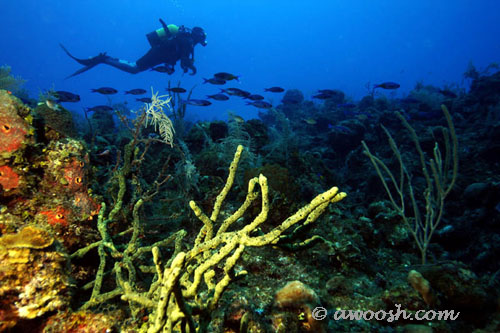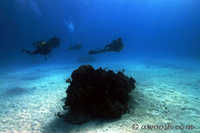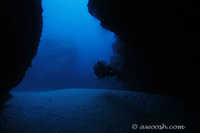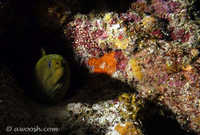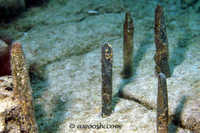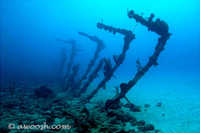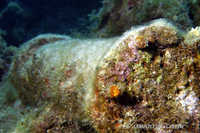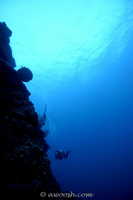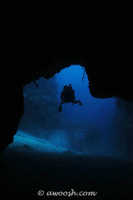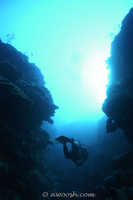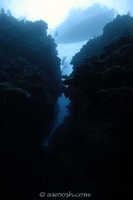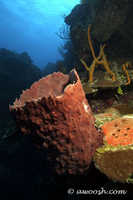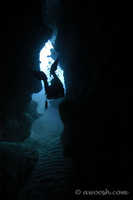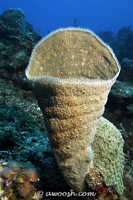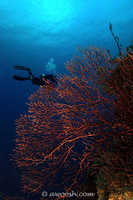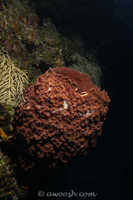Diving at Cuba's Maria La Gorda
The Good (& The Acceptable) I strongly suspect that somewhere high up in the Cuban government bureaucracy that oversees tourism, and particularly dive tourism, there is a grand poobah who has decided that the only way to prevent dive accidents is to ensure that are all dive tourists in Cuba are kept under constant surveillance. This was the case at Playa Pesquero and again at Maria La Gorda. I don't have huge objections to being guided as long as I am placed in small groups with divers of similar abiliity and air consumption, and as long as the dive guide understands that in addition to touring the reef, I am also trying to capture images of it. In fact, I've found that a good guide (who has left his tank banger on the boat and cruises slowly) takes away the need to worry about finding the boat at the end of the dive. The same guy also knows where to find the best topographical and creature features of the reef. After all, you're diving in his back yard.
It took a couple of days to tune up the dive staff at Maria La Gorda and help them to realize that we don't need (or like) to be babysat. We never make a big deal about it, we just walk the walk (or dive the dive, in this case). Having our own equipment and computers, being competent, non gas-guzzling divers who are respectful of both the reef and the limits imposed by the dive guys, not to mention schlepping a bigass camera, probably help the perceptions. By Day 2 they stopped asking us to report our air consumption 15 minutes into the dive. By Day 3 they didn't get all stressed out if I lagged behind the group a bit to take a picture, and even left us stay down an extra 10 or 15 minutes at the end of our dives, as long as we didn't stray far from the boat anchorage. By Day 4, encouraged by our many compliments about the fine diving and thanking them for the good dives, they were bending over backwards to show us the very best sites that Maria La Gorda has to offer. On one murky afternoon dive, three different divemasters got in the water near the end of a dive to help locate the wonderful 1700's wreck of a Spanish galleon that they knew I wanted to photograph.
Maria La Gorda has a diverse clientele - mostly Europeans, with a sprinkling of South Americans and Canadians thrown in for good measure. It is not at all unusual to hear 7 or 8 different languages being spoken on the dive boat. Some people, like us, come to Maria La Gorda specifically for a dive holiday. Others are traveling around Cuba and drop in for a few days to do a few dives. As such, there was a pretty large cross section of diving abilities - from brand newbies in rental gear who were on their first ocean dive, to seasoned divers with hundreds of dives under their belt. The dive staff at the Maria La Gorda handled all this very well. Groups were formed on the boat, according to experience, with a maximum of 6 divers to a group. On several occasions the chief honcho of the dive guys put La Familia (that would be the 3 of us) in his group and did not add any other divers. It was pretty sweet. They also made sure that our "advanced group" was first in the water, to make sure we got the longest, least congested dives. We really appreciated this treatment.
Dive briefings were conducted in English, and since English is very much a second language for the dive guys (and for most of the guests), it went pretty much like this, for all dives: "We are at ___________(name of dive site). This is a very beautiful place with a beautiful wall. Maximum deep for advanced divers will be 30 metres. Beginner divers maximum deep 20 metres. You, you and you are in ________(name of DM)'s group. We will make a 45 minute dive. We will do a 3 minute stop at 5 metres at the end of the dive. Please be ready."
The Bad (& The Contemptible) Maria La Gorda, for all its many charms, has a few warts as well. I am always saddened to see dive boats anchoring on the reef, and in an area like Maria La Gorda where the dive sites are visited and dived over and over again, there is no excuse for not having permanent moorings installed. It is enough to break my heart to circle around under the boat at the end of a dive and see a rusty anchor gouging into the coral, with sheared off corals, sponges and sea fans around it where the drag of the anchor and the lag of the chain have done their damage. The other thing that I found greatly disturbing, though not of any direct consequence to us, was that the rental gear at Maria La Gorda did not include a depth gauge. Even though the dives are guided and divers are expected to stay at the level or above the dive staff who all use a dive computer, we saw many occasions when divers were diving several feet below their guides for long lengths of time. We also saw guides (occasionally) taking divers well below the prescribed 30 metres maximum depth. The steep and deep nature of the terrain at Maria La Gorda really should require all divers to have, at the least, a depth gauge, and ideally a dive computer. By the end of our 10 day stay, my Suunto Vyper (albeit very conservative, as am I in my dive practices) was flirting with deco on almost every dive. You can't expect a monster like Ivan to blow directly through an area and not leave any damage in its wake. The effects on the reef at Maria La Gorda are quite varied. On some sites to the north of the resort (where the galleon wreck is located in 15 feet of water), there is little to no discernible damage and the coral gardens flourish. At some of the sites to the south (where the amazing caves and swim-thrus are located), the top of the reef is to all appearances dead and covered with sand. In fact, it appears that it was not so much the wave action that did the damage as it was the sand that it kicked up. As an example, I was surprised to see that there were very few of the fragile sea fans that had been knocked over. It really looks like it is the deposits of sand left on the corals that are killing them. Even more alarming, in areas of coral die back, there is alot of green algae-like matter growing over top of the corals, in effect smothering any possibility of the coral regenerating itself. Even at depth, and on the steep walls, there is significant silting on all the corals and sponges on some sites, and I worry for their future survival. I can only imagine how absolutely incredible some of these vertiginous, coral and sponge covered walls must have been, prior to the hurricane.
Practical Stuff There are two dedicated dive boats at Maria La Gorda, as well as a charming wooden vessel that takes out groups of picnickers and snorkelers.
The dive boats are in good shape, and have molded tank racks that do a great job of securing AL80 tanks. However, most of the tanks supplied are those stubby steel tanks (I think they are 72's) and they don't fit as well. No matter, it was a vaste improvement over our experiences at Playa Pesquero in terms of on-board gear storage and as an added bonus, we didn't have to swim out to the boat at Maria La Gorda. The forward portion of the boat is under cover (there is a dry cutty cabin in the bow) and there is a sun canopy from midships to stern, as well as room for a few divers up on the flying bridge. The boats comfortably take 20 divers, although they managed to squeeze something close to 30 divers one morning we were there (which, being over Christmas, was peak season). There is a radio on the boat and what looks to be an 02 kit. There is also a small camera table of sorts (hang on to your rig in rough seas), but no camera bucket. Drinks and snacks are not supplied. Nitrox is not available at Maria La Gorda. Rental Gear (mostly Mares), for the most part in decent shape, is available at the dive shop, including wetsuits. Full gear rental is $10 per dive. BCD & reg is $5. They do have large freshwater rinse tanks outside the dive shop, but no dedicated camera rinse. We also chose not to leave our gear and wetsuits hanging out beside the shop - it is just too easy for people to take stuff, what with guests and day visitors coming and going to and from the resort constantly in rental cars. Folks can drive right up and park next to the gear drying rack. There are also no gear lockers. So, we rinsed our gear and schlepped it to and from our cabin daily where we dried it on the front veranda. We were glad that we brought our mesh backpacks. We were advised by Cubafriends.ca (the travel agent) to prepay our dive packages from Canada to save money. I was very glad we did. Our cost for a 15 dive package was US$276.00 (works out to $18 a dive - a steal). Buying the same package at the resort would have cost us $345.00. There was a price posted for night dives (I recall it was $40), but I never saw the boat go out. They do let private groups book out an entire dive boat for dive excursions - there were several groups of Europeans who appeared to be on some sort of tour, and who were taken out separately from the regular diving guests. Three dives are offered daily - two in the morning and one in the afternoon, seven days a week, holidays included. The posted dive times seemed to have little to do with the actual departure time. The boat almost always returns to the resort between dives to refill the tanks, which are schlepped to/from the compressor shack on a dolly. Anticipating shallower dives for the second and the third dive of the day, they would often put snorkelers on the same boat as divers. This was never a problem - divers went in first and sometimes we were dropped off a wall and from there made our way back up to the shallower part of the reef where the boat was subsequently anchored for the snorkelers. The water temperatures stayed at a steady 81F Suunto degrees. We wore 3/2 full suits with hooded vests and managed to stay warm on our dives. Air temperatures dropped below the water temperature for several days during our trip (December 2004), and I was very glad that I brought a lightweight fleece pullover and a windbreaker to slip on after the dives for the ride back. The dives sites are all within 20 minutes of the resort, making for easy boat rides. The large bay in which Maria La Gorda is located is out of the prevailing winds, and so the the seas tend to be quite calm. We only lost one day of diving in our 10 day stay when a howling westerly blew right into the face of the resort and created large surf. The boats were removed to safe moorage during that time.
And So, In The End, The Fat Lady Sings It is a song about an almost impossibly beautiful, remote place at the very western tip of a culturally rich, handsome and unspoiled country. And it is a song about a hurricane of mythic proportions that has swept over the magnificent reefs at Maria La Gorda and left some of them gasping for life. Maria La Gorda is a dive resort of yesteryear, before mammoth 200 room hotel chains with 3 pools, 4 restaurants and a swim up bar took over the great dive spots of the world. It's one of those places where you only have to wear long pants to dinner as defense against the bugs. But my travels there are bittersweet because it is a place that so many of my diving friends are forbidden by their government to visit. And because it is a place where so many wonderful Cuban people are not allowed to be free. The things that I will remember most about diving at Maria La Gorda are: the amazing terrain (imagine the best of Cozumel, without the crowds and the current); the healthy proliferation of life - turtles, rays, some schooling fish (highlighted by huge aggregations of creole wrasse waterfalling over the reef's edge into the abyss); all varieties of Caribbean reef creatures seemingly present and in decent populations; some really mammoth eels (including two of the biggest green morays I have ever laid eyes on); and an amazing array of sponges and corals. The dive guys said that they see whalesharks cruise by from time to time, as well as migrations of hammerheads. We saw a small manta in the shallows, near the beach when returning from a dive one morning. They said they are seen at Maria La Gorda quite often.
The vertical, seemingly bottomless walls, the huge and numerous swim thrus and caverns, the remnants of an 18th century Spanish galleon, along with the rest of the generally interesting underwater topography and the beautiful coral gardens in the shallows, combine to provide a really diverse and exciting diving experience. I will also fondly remember the dive staff at Maria La Gorda - an almost unanimously delightful and fun-loving group of guys whose fate it is to toe the party line. The Cubans at Maria La Gorda are good-natured, full of enthusiasm and clearly love to dive. They are very proud of their work, and of their beautiful country. As they should be. Maria La Gorda is not the Galapagos in terms of quantity of life in the water. But of all the Caribbean diving I have done to date, it ranks right up there with the very best. I sure wish I had the chance to see it before Ivan came calling.
More Information About Diving and Traveling in Cuba: Maria La Gorda: Maria
La Gorda Multimedia Slideshow Havana: Havana
Multimedia Slideshow Playa Pesquero: Playa
Pesquero Multimedia Slideshow
|
